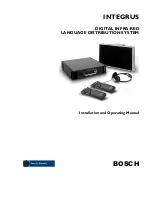
14
| en
INTEGRUS | Digital Infra-red Language Distribution System
BOSCH Security Systems B.V.| February 2003
W
H
L
X
Figure 1.20 A typical rectangular footprint for a mounting angle of
15
G
X
W
H
L
Figure 1.21 A typical rectangular footprint for a mounting angle of
90
G
The guaranteed rectangular footprints for various number of carriers, mounting heights and mounting angles can be found in
section 7.6. The height is the distance from the reception plane and not from the floor. Guaranteed rectangular footprints can
also be calculated with the footprint calculation tool (available on the documentation CD-ROM). The given values are for one
radiator only, and therefore do not take into consideration the beneficial effects of overlapping footprints. The beneficial effects
of reflections are also not included.
As rule of thumb can be given for systems with up to 4 carriers, that if the receiver can pick up the signal of two adjacent
radiators the distance between these radiators can be increased by a factor 1.4 approximately (see Figure 1.22).
L
R1
R2
R3
R4
R1
R2
R3
R4
W
1.4
W
1.4 L
Figure 1.22 The effect of overlapping footprints
1.4.2 Planning
radiators
Use the following procedure to plan the radiators:
1. Follow the recommendations in section 1.3 in order to determine the positioning of the radiators
2. Look up (in the table) or calculate (with the footprint calculation tool) the applicable rectangular footprints
3. Draw the rectangular footprints in the lay-out of the room.
4. If the receiver can pick up the signal of two adjacent radiators in some areas, determine the overlap effect and draw the
footprint enlargement(s) in the lay-out of the room.
5. Check whether you have sufficient coverage with the radiators at the intended positions.
6. If not so, add additional radiators to the room.
7. For larger systems and systems with more than 4 carriers, use the Ease-IR simulation program for optimising further the
overlap effect and at the same time taking into account the multi path effect.
See Figure 1.15, Figure 1.16 and Figure 1.17 for examples of a radiator lay out.















































